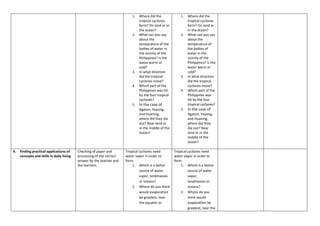This document is a daily lesson log for a Grade 8 science class. It outlines the objectives, content, procedures and reflections for lessons on understanding typhoons. The objectives are for students to explain how typhoons develop and are affected by landmasses and water, and trace typhoon paths using maps and data. The content covers the formation and movement of typhoons in the Philippine Area of Responsibility. Procedures include discussing conditions for typhoon formation, plotting typhoon locations on a map, recalling impacts of past typhoons, and assessing students' understanding. Reflections address student performance and opportunities for improvement.






